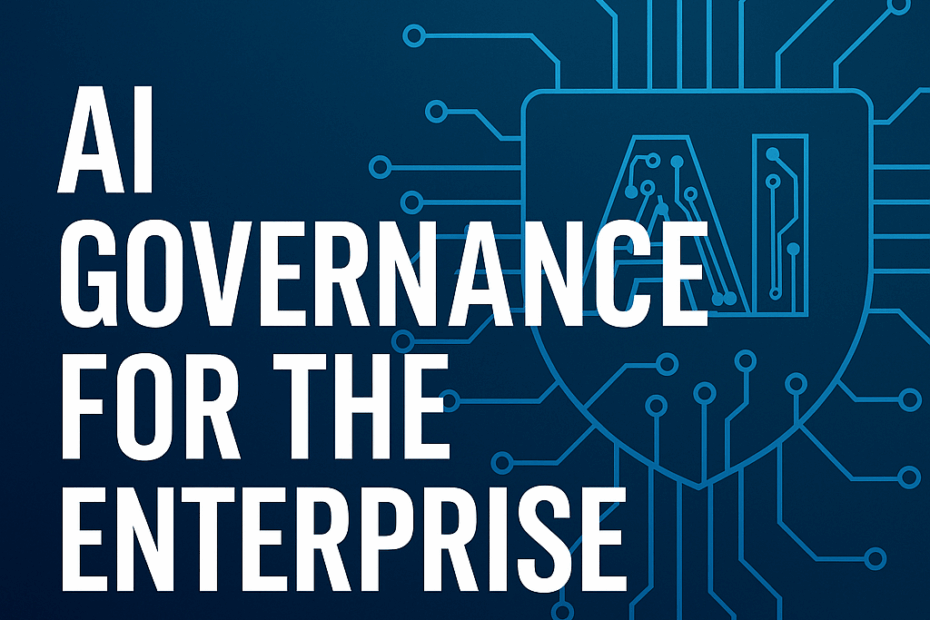The Enterprise AI Governance Blueprint: Best Practices for 2025 and Beyond
Artificial Intelligence is no longer a future consideration — it’s here, embedded in the daily operations of enterprises across industries. From predictive analytics in manufacturing to generative AI in marketing, organizations are racing to unlock AI’s transformative potential.
But while the technology moves fast, trust moves slowly. Enterprises cannot afford to let AI adoption outpace the guardrails that keep it ethical, compliant, and aligned with business goals. This is where AI governance comes in.
At Veritopa, we’ve seen the same challenge across pharmaceuticals, finance, manufacturing, and high-growth startups: organizations know AI can be a game-changer, but they lack the governance structures to make it safe, sustainable, and strategically valuable.
What Is AI Governance?
AI governance is the framework of policies, processes, and roles that ensure an organization’s AI initiatives are transparent, fair, compliant, and accountable. It covers the entire AI lifecycle — from data collection and model training to deployment, monitoring, and retirement.
A robust governance program answers critical questions:
- How do we ensure our AI models are free from harmful bias?
- Who is responsible when an AI-driven decision goes wrong?
- How do we comply with regulations like GDPR, HIPAA, or CCPA?
- Can we explain an AI decision to a regulator, customer, or board member?
Without clear answers, AI can quickly become a risk rather than an asset.
Why Governance Is a Business Imperative
Some leaders still see governance as a bureaucratic speed bump — a set of hoops to jump through before innovation can happen. The reality is the opposite: governance accelerates AI adoption by building trust internally and externally.
When employees understand the rules of engagement, they’re more willing to experiment with AI. When customers know your AI respects their privacy and treats them fairly, they engage with confidence. And when regulators come calling, you can demonstrate compliance without scrambling.
In short, governance isn’t a barrier to innovation — it’s the foundation for responsible scaling.
Best Practices for AI Governance in the Enterprise
1. Start with Principles, Not Just Policies
Every AI initiative should be grounded in core principles like transparency, accountability, fairness, and security. Policies will evolve, but principles give teams a compass for decision-making in new and complex situations.
2. Define Roles and Responsibilities
AI governance fails when “everyone” owns it — which means no one does. Create a clear governance structure:
- AI Steering Committee for strategic oversight
- Data Governance Council for data quality and semantics
- Ethics Review Board for evaluating bias and societal impact
- MLOps/IT Teams for operationalizing governance standards
3. Address Data Governance First
AI is only as good as the data it learns from. This means investing in:
- Semantic structuring for AI comprehension (one of Veritopa’s specialties)
- Metadata standards
- Data lineage tracking
- Security classification
Poorly governed data will undermine even the most sophisticated AI model.
4. Integrate Governance into the AI Lifecycle
Governance shouldn’t happen in a separate compliance meeting at the end of a project. Build it into every phase:
- Design: Ethics risk assessments
- Development: Bias testing and explainability documentation
- Deployment: Monitoring and alerting for drift or anomalies
- Retirement: Formal decommissioning processes
5. Make It Explainable
Black-box AI might work in the lab, but in the enterprise, stakeholders need to understand how decisions are made. Use model cards, datasheets for datasets, and explainability tools like SHAP or LIME to make AI decisions transparent.
6. Measure and Improve
Set metrics such as:
- % of AI projects governance-compliant at launch
- Reduction in bias detection scores
- Number of AI-related compliance incidents
- Time-to-deploy with governance in place
Review regularly to refine processes.
How Veritopa Approaches AI Governance
At Veritopa, our mission is simple: design AI solutions that actually work — not just in a demo, but in the real, messy environments where enterprises operate.
We help clients embed governance as a strategic enabler, not an afterthought. That starts with understanding the business goals and the regulatory landscape, then building governance structures that integrate with our AI-First methodology:
- Data Transformation Excellence – We turn fragmented, messy data into semantically rich, AI-ready datasets that meet governance standards from day one.
- AI-First Architecture – We design systems where governance is embedded in workflows, ensuring compliance and transparency without slowing innovation.
- Rapid Prototyping – We prove value quickly while maintaining ethical and regulatory guardrails.
- Continuous Improvement – Governance isn’t static; we help organizations evolve their frameworks as technology, laws, and business needs change.
The Competitive Advantage of Governance
Enterprises that take governance seriously don’t just avoid risk — they create a market advantage. In a future where AI regulation will only increase, companies with mature governance can adapt faster, win trust quicker, and deploy AI solutions with confidence.
As AI continues to reshape industries, governance will separate the leaders from the laggards. The leaders will be the ones who didn’t see governance as a box to check, but as a blueprint for responsible innovation.
At Veritopa, we believe that AI without governance is like a high-performance car without brakes: powerful, but dangerous. By embedding governance into every layer of AI strategy and execution, we help enterprises move fast — and do it safely.
If your organization is ready to scale AI with confidence, we’d be glad to help you put the guardrails in place.
Contact us: mike@veritopa.com
